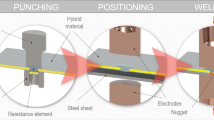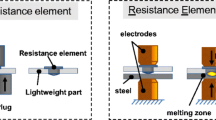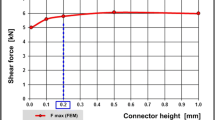Abstract
Weldability of a new lightweight sandwich material, LITECOR®, by resistance spot welding is analyzed by experiments and numerical simulations. The spot welding process is accommodated by a first pulse squeezing out the non-conductive polymer core of the sandwich material locally to allow metal–metal contact. This is facilitated by the use of a shunt tool and is followed by a second pulse for the actual spot welding and nugget formation. A weldability lobe in the time-current space of the second pulse reveals a process window of acceptable size for automotive assembly lines. Weld growth curves are presented together with results of numerical simulations made in the finite element computer program SORPAS® 3D, which is based on an electro-thermo-mechanical formulation. The numerical models are presented together with the specific modeling conditions leading to numerical simulations in good agreement with experimental results in the range of welding parameters leading to acceptable weld nugget sizes. The validated accuracy of the commercially available software proves the tool useful for assisting the choice of welding parameters.
Similar content being viewed by others
References
Belingardi G (2014) Lightweight design of vehicle body a contribution toward greener environment. Acta Technica Corviniensis - Bulletin of Engineering, Tome VII, Hunedoara, Romania, pp 165–169
Cordes R, Welsch F (2002) The new VW Polo—an example of modern lightweight body construction (in German). Dev Chassis Eng 1674:3–17
Hillebrecht M, Broek CT, Singh H (2012) Lightweight design for the future steel vehicle. Auto Tech Review 1(11):24–30
Singh S (2004) Can simulation of the welding process help advance the state of the art in resistance welding?, The 3rd International Seminar on Advances in Resistance Welding, Berlin, Germany, 5–11
Satonaka S, Iwamoto C, Qui R, Fujioka T (2006) Trends and new applications of spot welding for aluminium alloy sheets. Weld Int 20(11):858–864
Qui R, Iwamoto C, Satonaka S (2009) Interfacial microstructure and strength of steel/aluminum alloy joints welded by resistance spot welding with cover plate. J Mater Process Technol 209:4186–4193
Rudolf H, Yang Y, Broda T, Kotschote C (2013) Neuartige Widerstandspunktschweissenverfahren für den automobilen Aluminium-Stahl-Mischbau (in German), 22. DVS Sondertagung Widerstandsschweissen, Duisburg, Germany, pp 151–157
Meschut G, Hahn O, Janzen V, Olfermann T (2014) Innovative joining technologies for multi-material structures. Weld World 58:65–75
Kotschote C, Neudel C, Bergmann JP, Rudolf H (2013) Widerstandspunktschweissen von Aluminium-Stahl-Blechverbindungen mittels innenliegenden Stanzelementes (in German), 22. DVS Sondertagung Widerstandsschweissen, Duisburg, Germany, pp 1–6
Hoffmann O (2012) Environment oriented light weight design in steel. Ökologischer Leichtbau in Stahl, Hannovermesse Werkstoff-Forum, Hannover, Germany
Hoffmann O (2012) Steel lightweight materials and design for environmentally friendly mobility, Industrial Technologies 2012 integrating nano, materials and production. Aarhus, Denmark
Zhang W, Chergui A, Nielsen CV (2012) Process simulation of resistance weld bonding and automotive light-weight materials, The 7th International Seminar on Advances in Resistance Welding. Busan, Korea, pp 67–75
Wu P (2004) Testing and modeling of machine properties in resistance welding, PhD Thesis, Technical University of Denmark
Nielsen CV, Zhang W, Alves LM, Bay N, Martins PAF (2012) Modeling of thermo-electro-mechanical manufacturing processes with applications in metal forming and resistance welding. Springer, London
Nielsen CV, Zhang W, Martins PAF, Bay N (2015) 3D numerical simulation of projection welding of square nuts to sheets. J Mater Process Technol 215:171–180
Zhang W (2003) Design and implementation of software for resistance welding process simulations. Trans: J Mater Manuf 112(5):556–564
Bowden FP, Tabor D (1950) The fabrication and lubrication of solids, Oxford University Press
Author information
Authors and Affiliations
Corresponding author
Rights and permissions
About this article
Cite this article
Tanco, J.S., Nielsen, C.V., Chergui, A. et al. Weld nugget formation in resistance spot welding of new lightweight sandwich material. Int J Adv Manuf Technol 80, 1137–1147 (2015). https://doi.org/10.1007/s00170-015-7108-0
Received:
Accepted:
Published:
Issue Date:
DOI: https://doi.org/10.1007/s00170-015-7108-0




